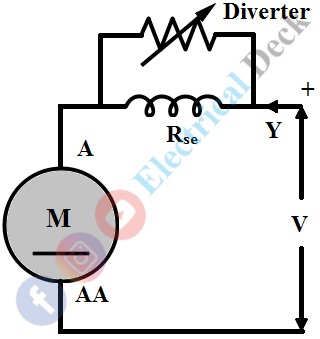In a dc motor, speed will depend on armature current and field voltage. So to control dc motor speed, field voltage or armature current should be changed.
In a dc series motor or universal motor, the speed is indeterminate and is largely affected by the load, but it can be affected by the input voltage. Hence you can control the speed of a dc series motor by following methods,
- Flux, (flux control method).
- Armature circuit resistance (rheostatic method).
- Applied voltage (voltage control method).
Flux Control Method :
The series motor flux can be varied by the following methods :
Field diverter :
A variable resistance called field diverter is connected across the series field. It diverts the main current and reduces the flux, thus increases the speed. It gives the speed above the normal only.
Armature diverter :
In order to obtain speeds below the normal speed, a variable resistance called armature diverter is connected across the armature. The diverter shunts some of the main currents, thus reducing armature current. Now, for a given load torque, if Ia is reduced, flux Φ must increase (since T α Φ Ia).
The result is that the motor draws more current from the supply and hence flux is increased. Since N α 1/Φ therefore motor speed decreases. Speeds lower than normal speed can only be obtained.
Rheostatic Control Method :
In this method, a variable resistance (rheostat) is connected in series with the armature winding. This reduces the voltage across the armature and hence speed falls. Below the normal speed (not above) can be obtained. It is uneconomical because large power loss takes place in variable resistance.
Tapped Field Control :
Another method of speed control of d.c. series motor commonly used in electric traction. In this method, the number of series field turns is changed in steps. The speed can be increased by cutting the number of turns. More number of tappings provide smooth variations of speed.




